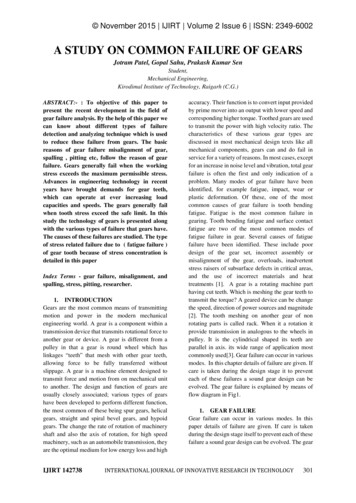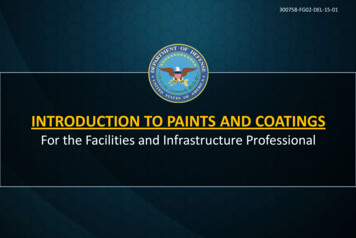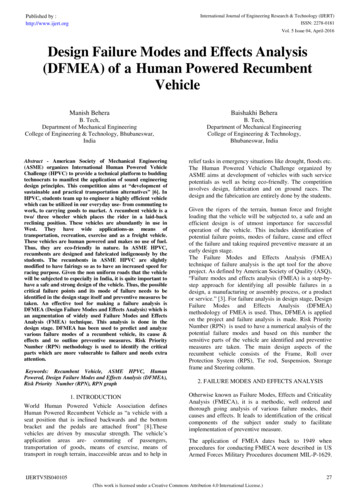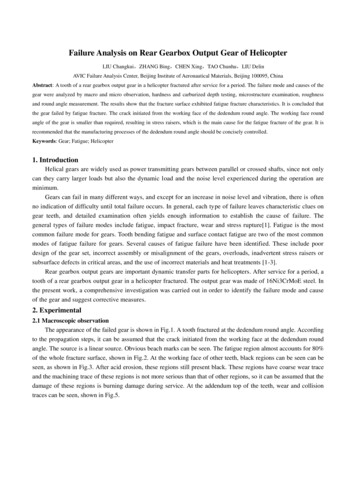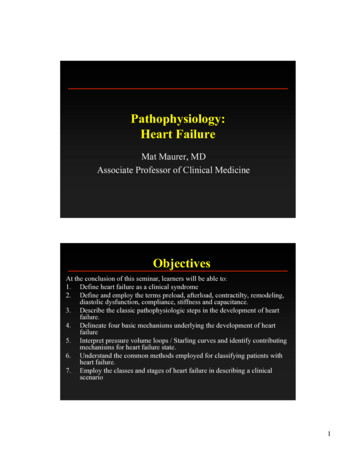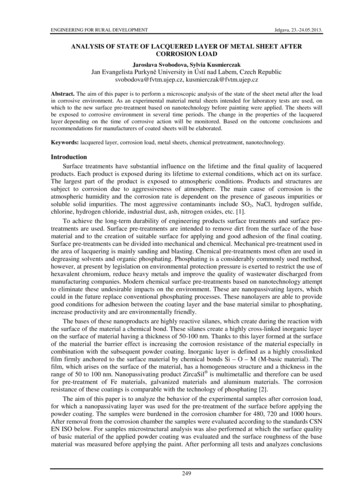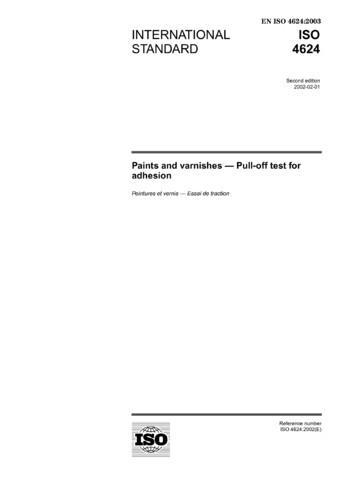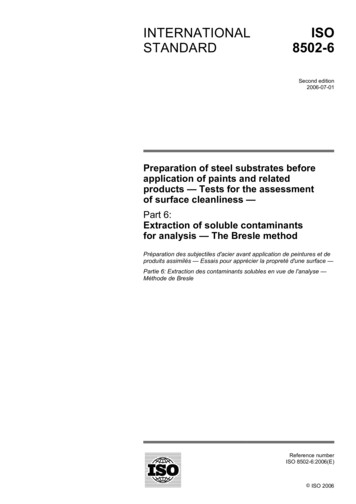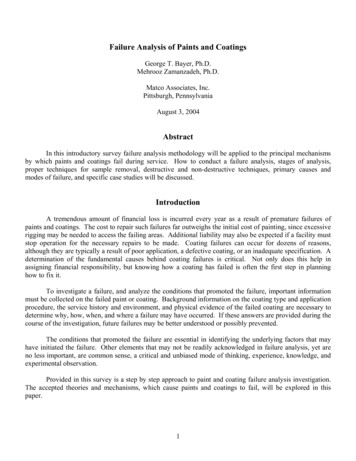
Transcription
Failure Analysis of Paints and CoatingsGeorge T. Bayer, Ph.D.Mehrooz Zamanzadeh, Ph.D.Matco Associates, Inc.Pittsburgh, PennsylvaniaAugust 3, 2004AbstractIn this introductory survey failure analysis methodology will be applied to the principal mechanismsby which paints and coatings fail during service. How to conduct a failure analysis, stages of analysis,proper techniques for sample removal, destructive and non-destructive techniques, primary causes andmodes of failure, and specific case studies will be discussed.IntroductionA tremendous amount of financial loss is incurred every year as a result of premature failures ofpaints and coatings. The cost to repair such failures far outweighs the initial cost of painting, since excessiverigging may be needed to access the failing areas. Additional liability may also be expected if a facility muststop operation for the necessary repairs to be made. Coating failures can occur for dozens of reasons,although they are typically a result of poor application, a defective coating, or an inadequate specification. Adetermination of the fundamental causes behind coating failures is critical. Not only does this help inassigning financial responsibility, but knowing how a coating has failed is often the first step in planninghow to fix it.To investigate a failure, and analyze the conditions that promoted the failure, important informationmust be collected on the failed paint or coating. Background information on the coating type and applicationprocedure, the service history and environment, and physical evidence of the failed coating are necessary todetermine why, how, when, and where a failure may have occurred. If these answers are provided during thecourse of the investigation, future failures may be better understood or possibly prevented.The conditions that promoted the failure are essential in identifying the underlying factors that mayhave initiated the failure. Other elements that may not be readily acknowledged in failure analysis, yet areno less important, are common sense, a critical and unbiased mode of thinking, experience, knowledge, andexperimental observation.Provided in this survey is a step by step approach to paint and coating failure analysis investigation.The accepted theories and mechanisms, which cause paints and coatings to fail, will be explored in thispaper.1
Failure AnalysisA failure analysis investigation is much like the work of a detective. Clues or relevant factspertaining to the investigation must be gathered, analyzed, explored, and studied to make a knowledgeabledetermination. As in the case of a good detective, first hand field experience is of the utmost important, yetacademic studies are also essential.Failure Analysis – Sequence of EventsJustification for conducting paint or coating failure analysis investigations is the most important issuefor a failure analyst. Corrosion protection, aesthetic, production, or litigation related purposes provideexcellent examples for justification.If the investigation is fully justified, the method for evaluation proceeds with the second step in theprocess. This step involves gathering relevant information and facts concerning the failure. The questionslisted serve as a guide to follow during the investigation. When the information has been obtained it must becarefully organized, labeled, and documented in a logical format for future reference.The failure analyst should question why failure occurred, how to get the building, facility, orequipment repair coated quickly if necessary, how to prevent a recurrence of the problem, and if moreinformation is needed, how can the information be readily obtained.With these steps taken a plan of attack can be formed. This is the single most important step in themethod of evaluation. A logical plan for the investigation to follow must be developed and implemented.Each investigation will be different from the last and many variables will make it necessary to makedecisions based on the investigation at hand. If an analyst is hasty in his decisions and does not have a solidplan the entire project may be ruined. By simply cutting or analyzing a sample carelessly an analyst coulddestroy his only useful evidence.The stages of analysis performed when conducting a paint or coating failure analysis investigationshould begin with the collection of background data and sample removal. This step includes site inspection,information regarding the current history of the failure, all relevant record keeping, and records on pastfailures if applicable.A preliminary examination of the failed coating and the substrate, as well as a non-destructiveexamination of the failure, with extensive photographic documentation, precedes any destructive laboratoryevaluation and analysis. The preliminary examination does not change or damage the failed coating orsubstrate in any way.At this point in the investigation the specimens should be selected and identified for furtherlaboratory testing and analysis. Management should be notified of any specimens collected from a paint andcoating failure, including the underlying substrate, are often damaged, and of little use after testing.There is a wide variety of testing methods currently available for failure analysis of paints andcoatings. Sophisticated and highly calibrated laboratory equipment can detect the slightest imperfections ona specimen, and accurately identify the inherent characteristics.2
A macroscopic examination of the surface of the selected specimen begins this stage of analysis,followed by a microscopic examination.A close examination of failed paint and coating chips using astereo microscope at magnification of 50x or less may reveal that one of the layers is brittle and full ofcracks, or perhaps that an entire layer of paint is missing. An examination of failed and non-failed samplesmay reveal that all of the failed samples are of improper thickness. A microscope at magnifications rangingfrom 50x to 1000x magnification can be used to examine the cross section of failed paint and coatingsamples for voids or inclusion, as well as observation of underlying corrosion products on substrates.A chemical analysis of the paint or coating, as well as the substrate and corrosion products is usuallythe next step. Chemical analysis techniques typically used in the laboratory for paint and coating failureanalysis are Fourier transform infrared spectroscopy (FTIR) for organic functional group analysis, scanningelectron microscopy (SEM) with associated energy dispersive x-ray spectroscopy (EDS) for elementalanalysis, and Auger electron spectroscopy (AES) for surface elemental analysis.Fourier transform infrared (FTIR) spectrometers record the interaction of infrared radiation (light)with experimental samples, measuring the frequencies at which the sample absorbs the radiation and theintensities of the absorptions. Determining these frequencies allows identification of the sample’s chemicalmakeup, since chemical functional groups are known to absorb infrared radiation at specific frequencies.The scanning electron microscope (SEM) is a microscope that uses electrons rather than light to forman image. There are many advantages to using the SEM as an adjunct to the optical (light) microscope. TheSEM has a large depth of field, which allows a large amount of the sample to be in focus at one time. TheSEM also produces images of high resolution, which means that closely spaced features can be examined ata high magnification. Preparation of the samples is relatively easy since most SEMs only require the sampleto be electrically conductive.Energy dispersive x-ray spectroscopy (EDS) systems are used in the characterization of materialsthrough the use of ionizing radiation to excite a sample. This excitation generates x-ray energies thatidentify the elemental composition of the sample. Using x-ray detection equipment to count the number ofx-ray photons emitted by this technique, an EDS system is able to characterize and quantify in anapproximate manner the elemental composition of the sample.Auger electron spectroscopy (AES) determines the elemental composition of conductive and semiconductive surfaces, and can provide elemental depth profiles through sputtering. This information can thenbe utilized to solve problems associated with surface appearance, cleanliness and bonding. In principle, anelectron beam bombarding a solid surface excites electrons from core electronic energy levels of atoms. Adeep core electron is knocked out of an atom, a shallower level electron drops into the deep core level hole,and its energy loss is transferred to another shallower-lying electron which can be ejected (the Augerelectron). The kinetic energy spectrum is used to identify the atom of origin and its concentration.Accelerated environmental exposure tests, such as salt spray (fog) tests, humidity tests, andultraviolet light (QUV) exposure tests can help to confirm the proposed failure mechanism of a painted orcoated substrate sample. Accelerated exposure testing can be complemented with electrochemicalimpedance spectroscopy (EIS). In the EIS technique capacitance and electrical properties of the coating aremeasured as a function of time. If the impedance ratio does not change as a function of time, then one canwith high degree of confidence conclude that the coating is not altered and performs very well under actual3
service conditions. The advantage of this technique is that we will not accelerate the test such that conditionswill result in the failure of coating system. The test will provide reliable data in a short time of exposure. Thedata from this test can also provide data for calculating permeation rate and minimum coating thickness andcure schedule requirements for adequate corrosion resistance.Analysis of the evidence, and a review of the existing data and documentation are the final stages offailure investigation. All information is gathered and analyzed to form a determination on the mode andprobable cause of the failure. Identification of the mode and cause of failure provide the source forrecommendations for corrective action. A final report including all relevant data, analyses, andrecommendations are compiled and presented to the client. In litigation investigations, the client may not beinterested in the recommendations section of the report.Collection of Background DataThe failure analyst should determine when, where, and how the paint or coating failure occurred.Interview all users and operators involved in the failure with point-related questions. Examples of pointrelated questions include “how was the coating-substrate handled after failure?” and “was it protected?”Sample RemovalThe decision to remove a sample specimen of a paint or coating, or of the underlying substrate, is avery important part of the failure analysis investigation. Sample selected should be characteristic of thecoating and/or substrate and contain a representation of the failure or corrosion attack. For comparativepurposes, a sample of the intact coating and/or substrate should be taken from a sound and normal section.In conjunction, for a complete microscopic and chemical evaluation and analysis, samples from the failure,adjacent to the failure, and away from the failure are necessary.The sample must be removed without changing the surface conditions or characteristics of thesample, nor inflicting physical damage of any kind. The sample is the basis on which the investigation andanalysis rely, and extreme care must taken not destroy any of the sample’s properties.Upon removal of the sample, the exact location where it was obtained must be documented both inwriting and by photography. Any corrosion product found on the coating or the substrate should also becollected and examined. If necessary, the corrosion product may be removed carefully from the substrateand sent with the removed sample. When the sample has been removed from the structure or the component,it should be carefully packaged in a water-tight container appropriate to the size on the sample, identified andlabeled.Paint and Coating FailuresThe majority of paint and coating-related failures can be attributed to six primary causes. Thesecauses are as follows.1.Improper surface preparation – the substrate surface is not adequately prepared for the coatingthat is to be applied. This may include cleaning, chemical pretreatment or surface roughening.4
2.Improper coating selection – either the paint or coating selected is not suitable for the intendedservice environment, or it is not compatible with the substrate surface.3.Improper application – this can be a problem with either shop-applied or field applied coatings,and occurs when the required specifications or parameters for the application are not met.4.Improper drying, curing and over coating times – again, this problem relates to a lack ofconformance to the required specifications or parameters.5.Lack of protection against water and aqueous systems – this is a particularly serious problem withaqueous systems containing corrosive compounds such as chlorides.6.Mechanical damage – which results from improper handling of the painted or coated substrate,resulting in a breach in the paint or coating.There are innumerable possible failure modes which can result from these primary causes. For thepurposes of this review paper, the failure modes will be divided into three general categories, as follows.1.Formulation-related failures.2.Substrate-related failures.3.Physical defect-related failures.These three general categories of failure modes will be described briefly.Formulation-Related FailuresThere are many types of paint and coating failures for which the coatings or corrosion engineer haslittle or no control over. These types of failures are related to the formulation of the coating itself. If thecoating system that is selected by the engineer is formulated inadequately, the coating will most likely failregardless of all efforts made in an optimal application. These formulation-related failures occur as a resultof the ingredients used and their formulation in the paint or coating. These ingredients include the resinsused, the pigments used, as well as the solvent formulation. Several specific types of formulation-relatedfailures are presented in Table 1, as well as appearances, causes, and problem prevention. They includechalking; erosion; checking; alligatoring; cracking; mud crack; wrinkling; biological failure; anddiscoloration for organic coatings; and checking; mud cracking; and pinpoint rusting for inorganic (zinc)coatings.5
Table 1. Formulation-Related FailuresOrganic CoatingFailures1. Chalking2. Erosion3. Checking4. Alligatoring5. Cracking6. Mud CrackingFailure AppearanceSurface soft & powdery.Easily wiped away.Similar to chalking. Highspot removal & brushmarks.Uneven, small, noncontinuous coatingfissures.Large macro-crackingand cross-hatching.Small breaks in coatingto substrate of variousgeometries.Large macrocrackingand curling.7. WrinklingFurrows and ridges incoating surface.8. BiologicalFailureSoftening or slime reaction.Blotchy brown or blackspots.Yellowing, graying, ordarkening.9. DiscolorationCause of FailureUV degradation ofresin. Improperpigmentation.Chalking & surfaceweathering.Surface stressescaused byshrinkage.Internal stresseswith greater surfaceshrinkage.Stresses due tocontinued polymerization/oxidation.Rapid drying ofhighly filled coatings.Surface dries morequickly thanunderlying coating.Bacterial or fungaldegradation.Weathering orchemical reaction.Problem PreventionUse UV-resistant resinsand non-chalkingpigments.Use chalk-resistantcoating with goodflow.Use weather-resistantresins and inertpigments.Apply thin coatsand thoroughly drybefore reapplication.Use non-reactive resinsand pigments.Use coatings with strongadhesion and properdrying conditions.Use coatings with even,thorough dryingcharacteristics.Use permanent fungicidesor bactericides incoating.Use color stable resinsand pigments.Inorganic (Zinc)Coating FailuresFailure AppearanceCause of FailureProblem Prevention1. CheckingFine visible or microscopic High zinc pigment/binder Use reinforcing pigments,checks that do notratio. Rapid dryingthin layer applicationpenetrate to substrate.conditions.and proper drying.2. Mud CrackingFine to large segmentsToo thick application.Use recommended thicknessflaking from surface.Too rapid drying.and proper drying method.3. Pinpoint Pinpoint spots of corrosion.Improper zinc/binderRemove and reapplyRustingearly failure can beratio. Uneven coatingmore satisfactory coatingcatastrophic.thickness.at first indication.(Source: Steel Structures Painting Council, Causes and Prevention of Paint Failure, Chapter 23, GoodPainting Practice, Steel Structures Painting Manual, 1982.)Substrate-Related FailuresA substantial percentage of paint and coating failures are related to the substrate to be coated and itsproper preparation prior to coating. To eliminate this class of paint and coating failure, it is imperative that6
the painters and coating applicators take great care in following specified methods of surface preparation.There is no substitute for proper surface preparation if long service lifetime is expected from the paint orcoating. Several specific types of substrate-related failures are presented in Table 2, as well as appearances,causes, and problem prevention. They include previously used steel; galvanized or metallic zinc surface;aluminum; copper; wood; and concrete.Table 2. Substrate-Related FailuresCoating Failure1. PreviouslyUsed SteelFailure AppearanceBlistering, rust,tubercles, loss ofadhesion.Cause of FailureRetention of minuteamounts of corrosionproduct; even afterabrasive blast.Problem PreventionWash blasted surfacewith water or dilutephosphoric acid andre-blast. Use anticorrosive primer withstrong adhesion.2. Galvanized orWhite zinc corrosionFormation of zincBrush blast zinc surfaceMetallic Zincproduct forming undersalts underneathor use commercial zincSurfacecoating or breakingcoating.treatment. Use antithrough.corrosive primer withstrong adhesion.3. AluminumWhite corrosionSmooth aluminumLight blast aluminumproduct,oxide surface. Nosurface or use aluminumloss of adhesion,physical adhesion.treatment. Use antipossible blistering.corrosive primer withstrong adhesion.4. CopperGrey-green corrosionSmooth copperBrush blast copperproduct, loss ofoxide surface. Nosurface or use copperadhesion.physical adhesion.treatment. Use anticorrosive primer withstrong adhesion.5. WoodChecking, cracking, andExpansion andStart with clean newlyflaking of coating.contraction of wood sanded surface. Use elastic,Blistering from trappeddue to varyinghighly penetrating paintMoisture in wood.temperatures andwith high moisturehumidity.permeability.6. ConcreteBlistering, peeling, or loss Chemical reactivity, Concrete surface should beof adhesion. Formationmoisture contentclean and dry. Acid etch orof calcium salts underand porosity oflight blast. Use elastic,coating.concrete.highly penetrating paintwith alkali resistance(epoxy).(Source: Federation of Societies for Coating Technology, Pictorial Standards of Coating Defects,Chalking Resistance, Erosion Resistance, Mildew Resistance, Philadelphia, PA)7
Physical Defect-Related FailuresMany specific types of physical defects have been categorized and studied by the paint and coatingsindustry and by coatings and corrosion engineers. Many of these physical defect-related failure typesoverlap with the formulation-related failure and substrate-related failure types discussed above. However,these physical defect types and their nomenclature as discussed here are traditionally considered by the paintand coatings industry, and they merit a separate category. Several specific types of physical defect-relatedfailures are presented in Table 2, as well as appearances, causes, and problem prevention. They includeblisters; bubbles and craters; color mismatch; dirt; fisheyes; gloss variations; mottle; orange peel; runs, sags,and curtains; paint adhesion loss; soft paint films; solvent popping, boiling, and pinholes; and solvent wash.Table 3. Physical Defect-Related FailuresDefectFailure1. Blisters2.Bubbles andcraters3. Color mismatchFailure AppearanceDome-like raised areacontaining moisture orother liquids.Bubble: dome-like raisedarea containing vapor.Crater: concave areaonce covered by bubble.Color deviations fromone area/part to another.4. DirtAny contaminantsfound in paint or onpainted surfaces.5. FisheyesSmall depression witha central mound.6. Gloss variationsGloss deficient patchesof paint film.7. MottleMetallic paint; colorpigments separate frommetallic flake.Repetitive bumps andvalleys similar to anorange surface.8. Orange peelCause of FailureContamination onsurface prior to paintingor coating. Moisture inwood substrate.Solvent or moistureentrapment during dryingor baking.Problem SolutionClean surface prior topainting. Other meansof moisture escape forwood substrates.Application of coating inthin layers. Sufficientflash time before baking.Variations of filmwetness and build,substrate, thickness,application and agitation.Inadequate facilities,poor housekeeping, poorpainting practices.Consistency required infilm wetness, build,thickness, applicationand agitation.Improved housekeepingand attention to paintingpractices andprocedures.Keep painting areafree of silicone products.Use fisheye eliminators.Control bake ovenconditions, properapplication, consistentfilm thickness.Do not apply thepaint too wet.Caused by residual oil orgrease, especiallysilicone types.Basecoat wet spots,improper ovenconditions, insufficientfilm build.Application of paint toothick or excessively wet.Freshly applied paintfilm does not flow outsmoothly.8Proper paint sprayatomizing pressure,paint viscosity, and filmthickness.
9. Runs, sags andcurtainsDownward flow of paintsprior to film hardening.Application of coatingtoo thick or too wet.Proper spray guncleanliness andoperation. Correctsolvent amounts.10. Paint adhesionPremature separation of Contaminants, excessive Cleanliness, correct bakelosspaint film from substrate.bake time, condensedparameters, preventmoisture.condensed moisture.11. Soft paint filmsCoatings cured toImproper oven/cureCorrect bake parameters,hardness below aparameters, softeningavoid softening agents,designated specification. contaminants, excessiveproper solvent amountsolvents and film builds.and film build.12. Solvent popping,Tiny surface craters onOverly rapid solvent loss Avoid pigment clusters,boiling and pinholespaint films. Smallfrom the wet paint,controlling solventversions of bubbles andescaping as “bursts.”evaporation rates andcraters.oven temperatures.13. Solvent washPaint voids or areas withExcessive solventSufficient flash timethin paint due to solvent evaporation on entry area before painted parts entercondensation.of oven, condensation onan oven.cool area of part.(Source: Industrial Painting Principles and Practice, Second Edition, Norman Roobol,HanserGardner Publications, Cincinnati, OH, 1997.)Case Study Analysis of Paint and Coating FailuresSix case studies concerning paint and coating failures will be the focus of the following section. Theapproach adopted for each case study will provide the principal characteristics of the failure, mainidentifying features, basic problem solving techniques, and applied aspects of the failures.Case Study I – Corrosive Industrial EnvironmentA major power company requested an investigation to determine the cause of paint failures on thetwo storage tanks and associated piping at a trucking company facility. Peeling, or delamination, wasexperienced. The trucking company, which was approximately 1 mile distant from the client’s coal-firedpower plant, was laying the blame on the power plant’s stack emissions for peeling paint on the truckingcompany’s storage tanks and associated piping.In discussions with the power plant’s engineering department, it was determined that the plant wasmeeting the mandated gaseous emissions requirement of less than 1.2 pounds SO2 per million Btu output,which led to water vapor droplets containing sulfuric acid (H2SO4) and sulfate compounds. The actualmeasured stack emission averages 100 to 200 parts per million SO2. The plant emission of NOx rangedbetween 0.05 and 0.35 pound NOx per million Btu output. The particulate emissions from the stack wereprimarily silicon, aluminum, and iron oxides (87.7 weight percent), with small amounts of calcium,magnesium, sodium, and potassium oxides. Some water and sulfur trioxide was also present, and the loss onignition was 5.4 weight percent.9
Discussions with the trucking company representative focused on an attempt to obtain informationconcerning the type of paint applied and when the paint was applied to the storage tanks and piping. Therepresentative had insufficient knowledge to answer either of these questions.A site visit was made to the trucking company, and discussions were held with the client and arepresentative of the trucking company. Peeling paint was observed on both storage tanks, as well as on theassociated piping, and a pipeline flange. Photographs of the failures were taken, as illustrated in Figures 1through 3. Several measurements of the paint thickness were made on the pipeline, one tank, and a flange.All of the thickness measurements ranged between 4.5 mils (0.0045 inch) and 7 mils (0.007 inch). Samplesof the peeling paint were collected from one tank, the pipeline, and a flange. Also, a dark soot sample wascollected from the wall of one tank with tape.Fourier transform infrared (FTIR) spectroscopy was performed on the top sides of the paint chipsamples using the attenuated reflectance (ATR) technique. The under sides of the paint chips were toocontaminated with rust for FTIR analysis. All of the paint chip samples appeared to be of similar paint resinchemistry, and were phenoxy-based resin, as shown in the FTIR given in Figure 4.Energy dispersive x-ray fluorescence spectrometry (EDS) was conducted on both sides of each of thethree paint chips, as well on the soot sample at 20 kV accelerating potential. Figures 5 and 6 present EDSspectra for the top side and under side of a paint chip from tank #1. Figure 7 presents an EDS spectrum ofthe soot sample. Sulfur was found on both sides of the paint chips, as well as in the soot. Sulfur is notpresent in this paint composition as a pigment, resin, or additive, and so it must have been deposited from thelocal environment. The power plant and/or other industrial plant(s) in the area may have been potentialsources. Chlorine/chloride was also found on both sides of the paint chips, as well as in the soot.Chlorine/chloride is also not present in this paint composition, and also must have been deposited from thelocal environment. The elemental composition of the soot matched closely the elemental composition of thefly ash from the power plant.A sample of the pipe paint chip was mounted in cross section in epoxy, polished, and examined underan optical microscope. The chip examined did not display defects or trapped vapor bubbles. The chipappeared to possess two layers or coats of paint, with approximate thicknesses ranging from 1.2 to 3.0 milsfor the top layer and 2.1 to 4.9 mils for the bottom layer.The coating system originally selected for the trucking company storage tanks and piping was notresistant to the combination of industrial stack emissions and moisture present in the local environment.Sulfur and chlorine/chloride penetration to the steel substrate surfaces appears to be a contributing factor inthe delamination and peeling of the paint at the facility. Sulfur and chlorine in the form of chemicalcompounds may diffuse through an organic coating over time and reach the metal substrate, forming metalliccorrosion products, which will delaminate the coating from the substrate.The source(s) of the sulfur and chlorine/chloride cannot be proven with complete certainty. Based onthe known sulfur emissions of the nearby coal-fired power plant, it is highly likely that the power plant doescontribute a share of the atmospheric sulfur which ultimately deposits at the trucking company site.However, it is not certain whether or not other local sources of sulfur and chlorine/chloride exist, which maybe contributing to the problem.10
Based on past experience a coating resistant to industrial pollution should have been applied at thislocation. Recommendations were made here to mitigate the effects of sulfur on the tanks and piping at thetrucking company, with regard to repair and replacement coating. A known successful plant maintenancecoating system utilized for coal-fired power plants should also be used here for the trucking company storagetanks and pipeline. Adequate surface preparation would include a water blast at a minimum pressure of 4500psi using a rotary turbo nozzle to remove all loose paint, dirt and loose rust. This would be followed byapplication of the optimized primer, intermediate, and finish coats.Case Study II – Rural EnvironmentCorrosion failure occurred on a galvanized and painted sheet steel roofing material, measuring 16inches wide by 25 inches long, which had experienced corrosion and red rusting. The roof was located on anelementary school building, in a rural setting in the northeastern United States, and was not subject to anychemical fumes or salt spray. The roofing material was a 29 gauge, galvanized, 1-1/4 inch standing seemroof (SSR). Laboratory investigation of the failed galvanized and painted sheet steel roofing sampleincluded visual examination, Fourier transform infrared spectroscopy (FTIR), low magnification stereooptical microscopy, high magnification cross sectional optical microscopy, and scanning electronmicroscopy – energy dispersive x-ray spectrometry (SEM-EDS).Visual examination of the roofing material was undertaken. The
the next step. Chemical analysis techniques typically used in the laboratory for paint and coating failure analysis are Fourier transform infrared spectroscopy (FTIR) for organic functional group analysis, scanning electron microscopy (SEM) with associated energy dispersive x-ray spectroscopy (EDS) for elemental
